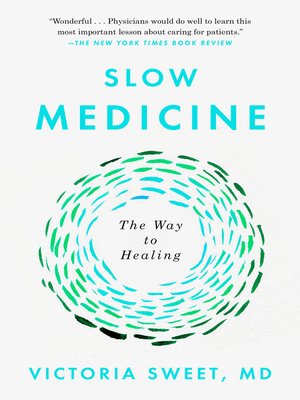
Sign up to save your library
With an OverDrive account, you can save your favorite libraries for at-a-glance information about availability. Find out more about OverDrive accounts.
Find this title in Libby, the library reading app by OverDrive.



Search for a digital library with this title
Title found at these libraries:
| Library Name | Distance |
|---|---|
| Loading... |
"Wonderful... Physicans would do well to learn this most important lesson about caring for patients." —The New York Times Book Review
Over the years that Victoria Sweet has been a physician, “healthcare” has replaced medicine, “providers” look at their laptops more than at their patients, and costs keep soaring, all in the ruthless pursuit of efficiency. Yet the remedy that economists and policy makers continue to miss is also miraculously simple. Good medicine takes more than amazing technology; it takes time—time to respond to bodies as well as data, time to arrive at the right diagnosis and the right treatment.
Sweet knows this because she has learned and lived it over the course of her remarkable career. Here she relates unforgettable stories of the teachers, doctors, nurses, and patients through whom she discovered the practice of Slow Medicine, in which she has been both pioneer and inspiration. Medicine, she helps us to see, is a craft and an art as well as a science. It is relational, personal, even spiritual. To do it well requires a hard-won wisdom that no algorithm can replace—that brings together “fast” and “slow” in a truly effective, efficient, sustainable, and humane way of healing.
Over the years that Victoria Sweet has been a physician, “healthcare” has replaced medicine, “providers” look at their laptops more than at their patients, and costs keep soaring, all in the ruthless pursuit of efficiency. Yet the remedy that economists and policy makers continue to miss is also miraculously simple. Good medicine takes more than amazing technology; it takes time—time to respond to bodies as well as data, time to arrive at the right diagnosis and the right treatment.
Sweet knows this because she has learned and lived it over the course of her remarkable career. Here she relates unforgettable stories of the teachers, doctors, nurses, and patients through whom she discovered the practice of Slow Medicine, in which she has been both pioneer and inspiration. Medicine, she helps us to see, is a craft and an art as well as a science. It is relational, personal, even spiritual. To do it well requires a hard-won wisdom that no algorithm can replace—that brings together “fast” and “slow” in a truly effective, efficient, sustainable, and humane way of healing.







